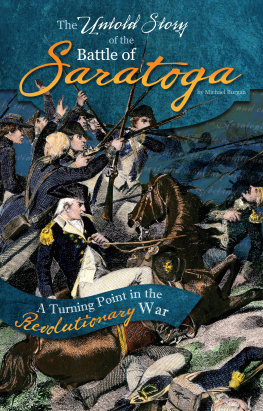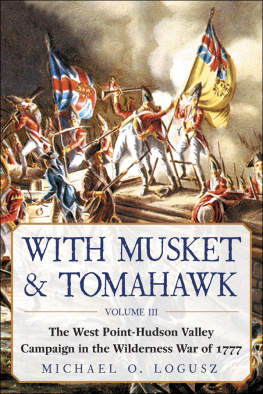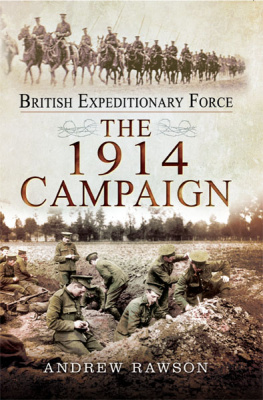
This edition is published by Papamoa Press www.pp-publishing.com
To join our mailing list for new titles or for issues with our books papamoapress@gmail.com
Or on Facebook
Text originally published in 2001 under the same title.
Papamoa Press 2017, all rights reserved. No part of this publication may be reproduced, stored in a retrieval system or transmitted by any means, electrical, mechanical or otherwise without the written permission of the copyright holder.
Publishers Note
Although in most cases we have retained the Authors original spelling and grammar to authentically reproduce the work of the Author and the original intent of such material, some additional notes and clarifications have been added for the modern readers benefit.
We have also made every effort to include all maps and illustrations of the original edition the limitations of formatting do not allow of including larger maps, we will upload as many of these maps as possible.
THE SARATOGA CAMPAIGN: MANEUVER WARFARE, THE CONTINENTAL ARMY, AND THE BIRTH OF THE AMERICAN WAY OF WAR.
by
Major Paul D. Montanus, USMC
TABLE OF CONTENTS
Contents
TABLE OF CONTENTS
EXECUTIVE SUMMARY
Thesis: That Maneuver Warfare is a quintessentially American way of war, and its application by the Continental Army during the Saratoga Campaign of 1777 enabled the Americans to defeat a much larger, veteran British force.
Discussion: The American conduct of the Saratoga Campaign during the Revolutionary War (May 1777 to Oct 1777) is a textbook study of maneuver warfare at the operational and tactical levels. The campaign pitted a highly trained, professional British army (which at the time was considered one of the most powerful in the world), well-versed in European attrition tactics, against a smaller, makeshift American force. The Americans, led by Generals Schuyler, St. Clair, Gates, and Arnold, and Colonels Stark and Morgan, were able to defeat the British because they employed maneuver warfare principles, a philosophy that was uniquely American, born out of the frontier experience. Although he was tasked to conduct a defense at Fort Ticonderoga, St. Clairs decision to withdraw in the face of superior force was in concurrence with Schuylers commanders intent. By executing the withdrawal, he ensured the survival of the operational COG.
Once the British Commander, General Burgoyne, made his fateful decision to take the overland route to Albany, Schuyler developed a brilliant campaign plan. He quickly and accurately assessed friendly and enemy COGs, and implemented operations that targeted enemy critical vulnerabilities and protected his own. His shaping operations canalized British movements to a single LOC, which made their movements predictable. His obstacles delayed the British advance to the point that Burgoyne was forced to wait several times to build up supplies, which facilitated recruitment and reconstitution of the American force. The delays so impeded Burgoynes progress that Schuyler was able to risk detaching sizable portions of his force to concentrate on separate enemy elements at Bennington and Ft. Stanwix. As a result of Schuylers shaping, Burgoynes cohesion was shattered, and his campaign culminated before he reached the field of battle at Saratoga.
At the First and Second Battles of Saratoga, the American commander, wisely listening to General Benedict Arnold, conducted an aggressive, forward oriented defense that seized the initiative from the British attacks and clearly disrupted their preconceived plans. Tactically, the Americans showed a proclivity for seeking gaps and avoiding surfaces. As a result of the two failed attacks on the Americans defensive positions at Bemis Heights, Burgoyne was placed into such a situation that he was forced to surrender or suffer annihilation. On October 17, 1777, General Burgoyne surrendered his army to the American commander.
Conclusion(s) or Recommendation(s): The Saratoga Campaign offers a uniquely American case study on the application of maneuver warfare techniques at the operational and tactical levels. The British defeat at Saratoga clearly demonstrates the superiority of maneuver warfare as a warfighting philosophy, and is of contemporary interest to the United States Marine Corps.
THE SARATOGA CAMPAIGN: MANEUVER WARFARE, THE CONTINENTAL ARMY, AND THE BIRTH OF THE AMERICAN WAY OF WAR
CHAPTER 1 BACKGROUND
Perhaps an unprecedented Instance that near 6,000 British & foreign Troops, under the command of an accomplishd General, should surrender themselves Prisoners of War in the field to an Army of raw Continental Troops & Militia! Henry Sewall, York, Maine Oct 17-18, 1777
Introduction
Since 1989, maneuver warfare has been the cornerstone of Marine Corps education and the hallmark of its operations, as defined by Marine Corps Doctrinal Publication-1 ( MCDP-1 ) Warfighting. Americas embracing of the tenets of maneuver warfare is not a post-1989 phenomenon. In fact, maneuver warfare is a quintessentially American way of war. This paper will focus on the Continental Armys conduct of the Saratoga Campaign, fought from May 1777 to Oct 1777. Although the campaign was conducted over 200 years ago, a detailed analysis of the campaign, using the concepts contained in MCDP-1 as a reference, will provide a unique and contemporary template.
The American victory, described as the turning point of the Revolutionary War, is more remarkable since the American army that faced the British force at the beginning of the campaign was a much smaller, less trained, admixture of regular and ad-hoc militia units. In contrast, the British force was a well-trained, professional force well versed in the modern, European, attritionist tactics of the age. Resourceful American leaders such as Generals Schuyler, St. Clair, Arnold, and Colonels Stark and Morgan displayed an uncanny knack for maneuvering their forces, avoiding the British strengths, attacking their weaknesses, and massing only when the situation clearly favored them. They shaped the battlefield, employed speed, surprise, and boldness to seize the initiative, and dictated the tempo on the battlefield. These maneuvers placed the British forces in a rapidly deteriorating situation from which they were not able to escape. The surrender of British General John Burgoyne to General Horatio Gates on the field of battle near Saratoga, New York clearly validates the superiority of maneuver warfare as a warfighting philosophy
This paper presupposes that the reader will have a basic, working knowledge of the Revolutionary War, and therefore will only examine specific events in detail when necessary to illustrate a central argument. Beginning with a brief review of the tenets of maneuver warfare and the general situation in order to establish an analytical framework, an analysis of the British and American strategic objectives and centers of gravity is conducted. Then, the corresponding operational objectives, campaign plans, and centers of gravity of both sides are analyzed. Finally, this paper will analyze the operational maneuvers and tactical actions during the campaign, focusing principally on the Americans. The analysis will show that the Americans utilized the principles of maneuver warfare to win the campaign, and therefore is of contemporary interest to the United States Marine Corps.










